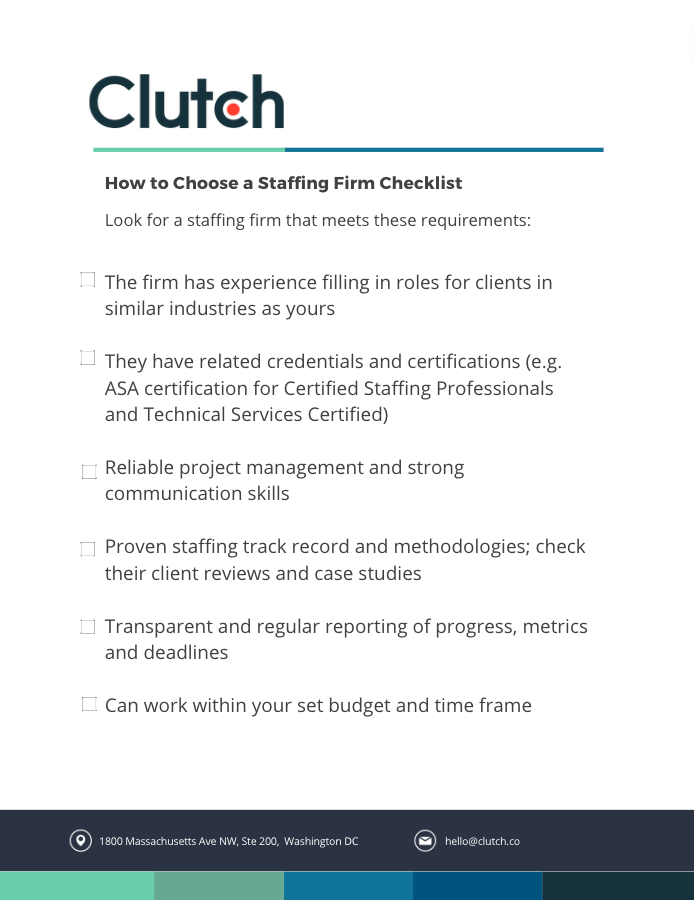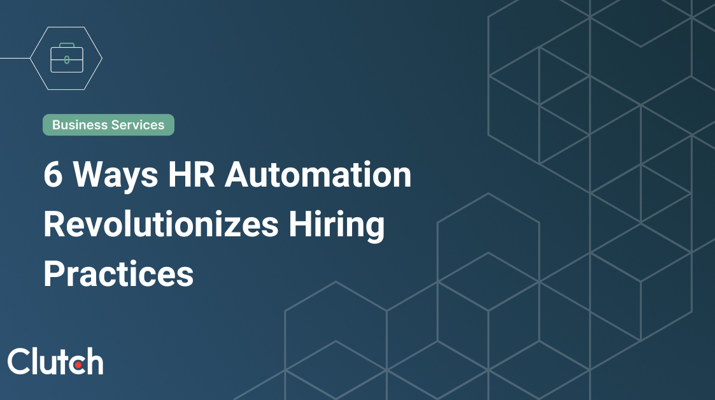

Updated May 7, 2025
The entire screening, interviewing, and hiring process can’t be done overnight, and some businesses simply don’t have the luxury of going through such time-consuming responsibilities. Staffing firms provide convenience and peace of mind to businesses everything from reviewing applications to signing new hires. This checklist will help you filter and find the ideal staffing firm for your needs.
Staffing services is the process of sourcing, vetting, and hiring suitable candidates for certain roles. Their job is essential to ensuring businesses have access to a wider talent pool but aren’t burdened with the tedious task of going through job-seeking platforms like LinkedIn and Indeed.
Essentially, staffing firms are a type of human resource service provider that focuses on helping clients match and hire top talent for various roles. They offer a variety of staffing solutions such as:
Looking for a Human Resources agency?
Compare our list of top Human Resources companies near you
Hiring a staffing firm brings a plethora of benefits such as faster hiring, lessen internal team workload, and better retention rates. These firms can handle every step of the process, from creating and promoting job descriptions to interviewing and handling job seekers’ paperwork.
Finding the ideal staffing partner for your startup or business can be tricky considering the many choices available in the market. In this piece, we’ll guide you through everything you need to know and consider when choosing a staffing firm.
How to Choose a Staffing Firm [Checklist]
Before you set out and search for a staffing firm, take a moment to establish your goals. Enlisting the service of a staffing firm isn’t a minor investment, so it’s best to know what you need, what your goals are, and what is your desired timeline.
Knowing what your objectives are will help you avoid getting upsold on by vendors, pinpoint the type of services you need, and communicate effectively when discussing your project.
One way to better understand your objectives is to sit down with your leadership team and internal HR team to talk about the project. Assess the current state of your organization, its staffing, and hiring operations, and that will help you know what type of return on investment (ROI) you’ll need from your future engagement.
Every business owner wants to get the most out of every investment they have, and budget will always be a major concern. Once you get a clear picture of your business and its objectives, it’s time to focus on preparing a budget. In this stage, research and facts are paramount.
As you do your research on the average costs of hiring staffing firms, your objectives will help you adjust your budget accordingly.
In addition to the type of staffing solution you’ll need, make sure to consider other factors such as the scope of services and the length of the partnership when you’re preparing a budget.
Typically, staffing agencies usually charge anywhere between 25% to 100% for every new employee they hire for your business. That doesn’t include the additional fees that some firms charge for contract buyouts or other extra work.
Your budget will help you when you negotiate about the costs and the scope of their services.
Check this piece to know more about the cost of staffing services: “HR Staffing & Recruiting Pricing Guide 2023”
Since there are different ways to search for potential staffing firms, it’s easy to feel overwhelmed by the choices. However, the objectives and budget you’ve set will make the search easier and less intimidating.
Companies can start their research by reaching out to colleagues within the industry to ask for their suggestions or referrals. Testimonials from people you personally trust can give you confidence but that doesn’t mean you can skip the next parts and immediately hire their recommendation.
Aside from the suggestions you’ve received, another way to research potential firms is by going through B2B directories like Clutch.
Clutch makes it effortless to research reliable service providers and you can filter them by priorities such as:
Setting criteria can help you save time when researching prospective firms.
It’s an impossible task to interview 20 firms to see if they’re the right fit for your project. Thus, shortlisting the potential partners is important before you proceed to the next stage.
After you’ve filtered the options, the next thing to do is to read up more on their client reviews and portfolios on third-party platforms. Clutch has a data-driven shortlist of the leading staffing companies where browsers can also access their hard-earned client testimonials.
As you read more about the experiences of their past clients, you’ll get to see more of how they work, what issues they have, and how efficient their staffing processes are. Reading reviews can help you avoid firms that have low ratings and have track records that show recurring problems with their clients.
Remember, shortlists are meant to be short. They only have around five to six firms that you’ll be reaching out to for the next step.
Reach out to the firms included in your shortlist to ask for an interview and a Request For Proposal (RFP), a business document that solicits a proposal for a service. Just like a resume, the RFP is a great reference for when you officially meet and interview the firm.
Reading through reviews and portfolios is a good basis for seeing the compatibility of a service provider but interviews are what seal the deal.
Before you hop onto the interview call or meet the representatives of the firm, make sure you prepare questions that will give you a deeper insight into their services. Consider including these key interview questions:
If you have any questions or concerns, ask the firm during the interview process and give them the opportunity to clarify every question you have.
Know more about what questions to ask here: “B2B Partnerships: Questions to Ask Potential Business Partners”
Now that you’ve completed the interview rounds and gathered all the information you need, narrowing down the final options to two or three is the penultimate stage.
Call your leadership team and even your internal HR team to once again discuss the remaining prospective firms in your choices. Weigh all the advantages and disadvantages of each firm and see which can bring the most value to your organization.
If you still feel overwhelmed by the final decision, take a step back and remember your priorities. Go with a firm that not only gives you confidence but also meets the objectives you’ve set.
Lastly, consider their company culture because it’s important to work with a partner who shares your values. During your interview, did you see if their culture matches your company’s culture? Compatibility across all aspects is crucial to a successful engagement.
Once you’ve finally determined which firm is the best choice for your business, reach out to them again to officially request a service level agreement (SLA).
SLAs are official documents or a contract that outline the scope of services and commitment between a service provider and a client. The paper goes into detail on the services, the terms and conditions, and the metrics they’ll deliver.
Don’t immediately sign the document once you receive it. Spare time from your busy schedule to read and review the contract before you put in your signature and commit to their services. As a business owner, it’s your duty to ensure your business avoids unfair risks.
When you review the contract, check the language, renewal provisions, and payment terms. Negotiate if you need to but don’t put your stamp if you don’t feel assured with the SLA.
Checklists keep you focused on your priorities. Use our template when you’re choosing the staffing firm for your project.

Download our detailed checklist before officially onboarding a staffing partner.
Whether it’s to handle seasonal influx in workload or finding temporary talents for projects, staffing firms save you time, and resources, and from headaches. The bottom line is, that the right partner can connect you with credible and qualified professionals to support your business growth.
With hundreds of firms in the market, choosing one can be tough. If you know what to look for and how the choice will feel less daunting. Identifying the right partner will bring more value to your investment.
You don’t need to look further to find reliable service providers. Browse through Clutch’s rankings of the leading staffing agencies and connect with a top partner.


